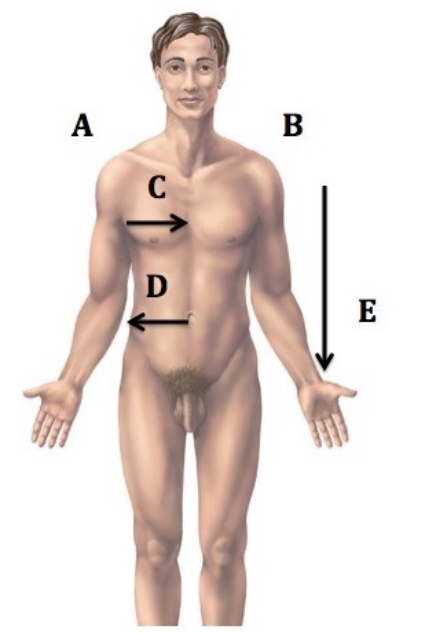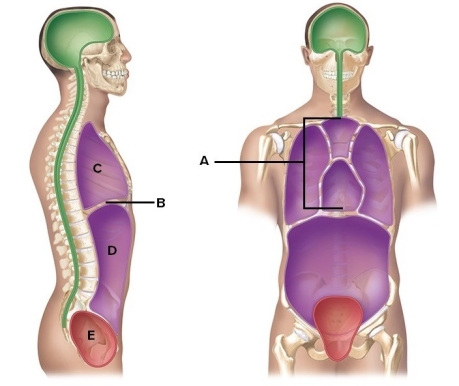A) groin
B) buttock
C) breastbone
D) upper arm
E) navel
G) B) and E)
Correct Answer

verified
Correct Answer
verified
Multiple Choice
 -This is a sagittal section through the abdominopelvic cavity. What serous membrane does "B" represent?
-This is a sagittal section through the abdominopelvic cavity. What serous membrane does "B" represent?
A) Visceral peritoneum (covers organs)
B) Mesentery
C) Parietal peritoneum (lines cavity)
D) Retroperitoneal organs
E) Peritoneal cavity
G) B) and C)
Correct Answer

verified
Correct Answer
verified
Multiple Choice
A construction worker was injured when a metal rod penetrated his abdominal wall inferior to his umbilicus and in the hypogastric region. The rod passed through to the lumbar region. Which of the following structures was most likely damaged?
A) Urinary bladder
B) Stomach
C) Kidney
D) Liver
F) B) and D)
Correct Answer

verified
Correct Answer
verified
Multiple Choice
The parietal peritoneum is
A) a double-layered serous membrane that anchors some of the abdominal organs to the body wall.
B) the serous membrane that covers the lungs.
C) the serous membrane that lines the abdominal and pelvic cavities.
D) the space located between the visceral and parietal pleura.
E) the membrane that lines the pericardial sac.
G) None of the above
Correct Answer

verified
Correct Answer
verified
Multiple Choice
Which of the following statements is TRUE?
A) The coordinated activity of the organ systems is necessary for normal function.
B) Because organ systems are so interrelated, dysfunction in one organ system can have profound effects on other systems.
C) An organism is any living thing considered as a whole, whether composed of one cell, such as a bacteria, or trillions of cells, such as a human.
D) Living things are highly organized, and disruption of this organized state can lead to loss of function and death.
E) All of these statements are true.
G) C) and D)
Correct Answer

verified
Correct Answer
verified
Multiple Choice
The delivery of a radioactive compound to the body to study the metabolism of tissues is called ________.
A) MRI
B) PET
C) DSA
D) DSR
F) None of the above
Correct Answer

verified
Correct Answer
verified
Multiple Choice
The integumentary system
A) regulates body temperature.
B) breaks down food into small particles for absorption.
C) controls intellectual functions.
D) produces body movements.
E) coordinates and integrates body function.
G) A) and E)
Correct Answer

verified
Correct Answer
verified
True/False
With regard to biomedical research, because rats, pigs, apes, and other mammals share over 90% of the same genes as humans, these animals are always good predictors for how humans will respond to a specific drug therapy.
B) False
Correct Answer

verified
Correct Answer
verified
True/False
Both the spleen and the urinary bladder are contained within the pelvic cavity subdivision of the abdominopelvic cavity.
B) False
Correct Answer

verified
Correct Answer
verified
Multiple Choice
The lumbar region is the
A) area in front of the elbow.
B) chest area.
C) lower back.
D) bottom of foot.
E) forearm.
G) None of the above
Correct Answer

verified
Correct Answer
verified
Multiple Choice
With regard to the validity of biomedical research in physiological studies, which statement is correct?
A) Although the general homeostatic mechanisms may be the same in some animal species, the individual variables are often very different.
B) Although the individual variables may be the same in some animal species, the general homeostatic mechanisms are often very different.
D) undefined
Correct Answer

verified
Correct Answer
verified
Multiple Choice
The antebrachial region is the
A) area in front of the elbow.
B) chest area.
C) lower back.
D) bottom of foot.
E) forearm.
G) D) and E)
Correct Answer

verified
Correct Answer
verified
Multiple Choice
 -Directional terms are important in the study of anatomy. What does "B" represent?
-Directional terms are important in the study of anatomy. What does "B" represent?
A) Median
B) Right
C) Left
D) Inferior
E) Lateral
G) B) and C)
Correct Answer

verified
Correct Answer
verified
True/False
A molecule of water is more complex than a mitochondrion (organelle).
B) False
Correct Answer

verified
Correct Answer
verified
Multiple Choice
Which of the following structures is located in the right-lower quadrant but NOT in the right iliac region?
A) Urinary bladder
B) Appendix
C) Large intestine
D) All of the listed organs are in both the right-lower quadrant and the right iliac region.
F) A) and C)
Correct Answer

verified
Correct Answer
verified
Multiple Choice
A major limitation of radiographs is that they
A) can only visualize bone.
B) give only a flat, two-dimensional image of the body.
C) are old technology that do not give good results.
D) have very few applications.
F) A) and D)
Correct Answer

verified
Correct Answer
verified
Multiple Choice
 -Here is a figure showing major body cavities and other structures. What does "D" represent?
-Here is a figure showing major body cavities and other structures. What does "D" represent?
A) Diaphragm
B) Mediastinum
C) Pelvic cavity
D) Thoracic cavity
E) Abdominal cavity
G) B) and C)
Correct Answer

verified
Correct Answer
verified
Multiple Choice
Which of the following is not a function of the control center within a feedback mechanism?
A) Receives and processes information
B) Controls effectors
C) Establishes a set point
D) Detects a change in the value of a variable
F) A) and C)
Correct Answer

verified
Correct Answer
verified
Multiple Choice
Medial means
A) toward the middle or midline of the body.
B) away from the surface.
C) closer to the head.
D) closer than another structure to the point of attachment to the trunk.
E) toward the back of the body.
G) A) and B)
Correct Answer

verified
Correct Answer
verified
Multiple Choice
An organ system is
A) a small structure within a cell.
B) a structure composed of several tissue types.
C) the basic structural unit of all living organisms.
D) a group of organs with a common set of functions.
E) a group of cells with similar structure and function.
G) C) and E)
Correct Answer

verified
Correct Answer
verified
Showing 21 - 40 of 140
Related Exams